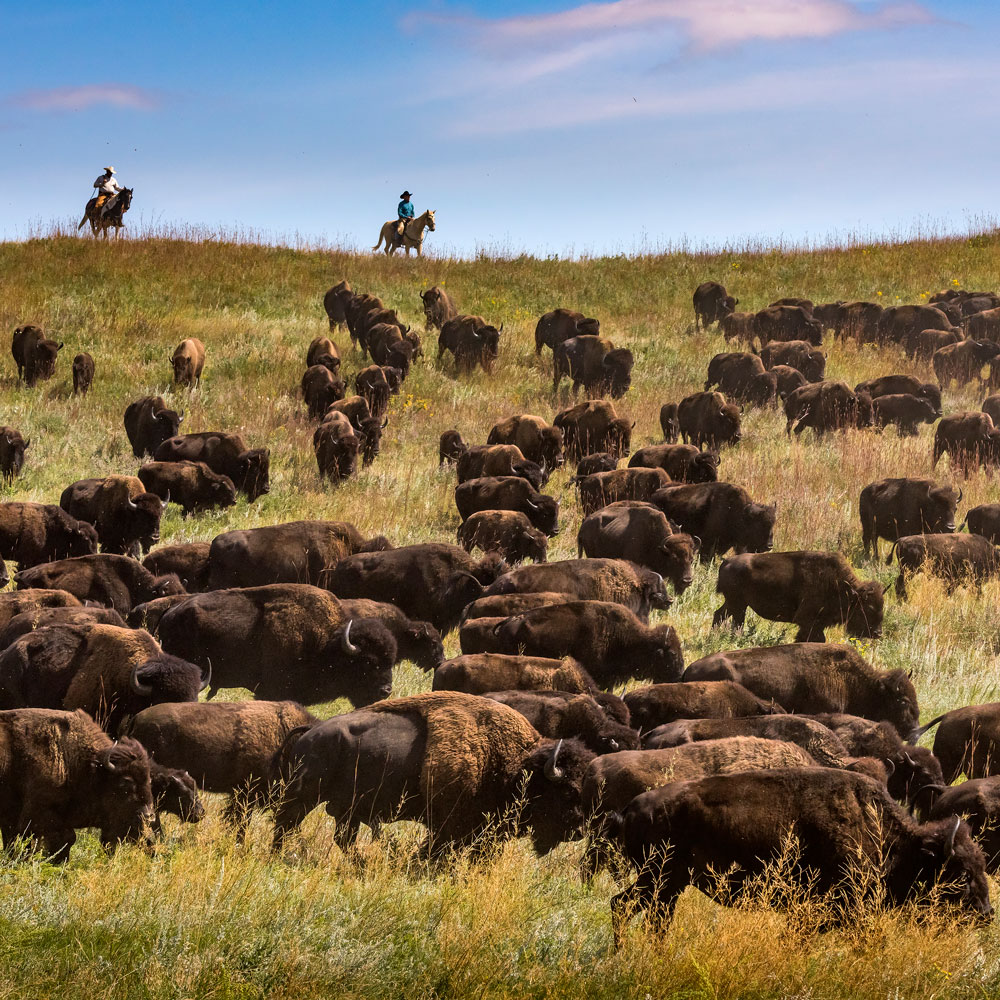By Pam LeBlanc
YES, THE PRESIDENTS ARE AWE-INSPIRING, but there’s even more to enjoy here

FROM ROLLING GRASSLANDS to towering granite spires, the Black Hills region of South Dakota feels straight out of an old Western flick. The indigenous Lakota people called the area Paha Sapa, or “Hills That Are Black.” But it’s the forests of ponderosa pines casting coal-colored shadows on the undulating landscape that inspired the name.
Highlights include the carved granite faces of Mount Rushmore and Crazy Horse, plus Custer State Park. Alongside that natural beauty, you’ll find surprising twists—gourmet restaurants, cozy lodges, wineries
and brewpubs.
Our suggestion? Start in Rapid City for a trip that combines history and outdoorsy adventure with a little luxury. There’s something everyone in the family will love on this road trip.
Hit the Road
One of the best routes for hitting the hotspots is the Peter Norbeck National Scenic Byway, a 70-mile jaunt over twisting bridges that cuts through Custer State Park and past Mount Rushmore and Crazy Horse. You’ll see waterfalls along the 19-mile Spearfish Canyon State and National Forest Service Scenic Byway to the north.


Where to Stay and Eat
Before hitting the road, order a sandwich—the Reuben, if you’re feeling traditional, or the gooey Pine Ridge—at the Bashful Bison Deli & Market in Rapid City, known for locally sourced ingredients.
Custer makes a good home base. Book a room at the Bavarian Inn, where the atmosphere is more casual alpine than Wild West. While in town, try the smoked trout BLT at The Custer Wolf, or toss back a beer at Mt. Rushmore Brewing Co. The motto at kitschy Baker’s Bakery & Cafe is “You’ll love our buns!” Pounding Fathers Restaurant cooks excellent bison steaks, but the best food comes from the upscale Skogen Kitchen, which serves duck, salmon
and steak.
Hop a Historic Train
The steam-powered 1880 Train has chugged between Hill City and Keystone since 1957 and once hauled construction materials for Mount Rushmore. Today, tourists settle onto wooden benches for the hour-long trip, getting glimpses of Black Elk Peak, the highest point in South Dakota.

Admire Stone-Faced Presidents
From Keystone, it’s a quick drive to Mount Rushmore National Memorial. A flag-lined promenade leads to an observation deck, where the likenesses of four U.S. presidents—George Washington, Thomas Jefferson, Theodore Roosevelt and Abraham Lincoln—stare back from the side of a mountain. Peruse photo exhibits, watch a film and examine tools in the museum.
Make a Stop for Wine
At Prairie Berry Winery near Hill City, sample wine made with chokecherries, buffalo berries and plums that grow wild here. It offers fruit wines, grape wines and wine fusions and is best known for a tangy mashup of rhubarb and raspberry juice called Red Ass Rhubarb. Seasonal offerings include Pumpkin Orange, which tastes like Halloween in a bottle.”


Ogle a Mind-Boggling Warrior
With eyes the size of pickup trucks, it’s hard to miss the largest mountain sculpture in the world. Korczak Ziolkowski began carving the Native American warrior in 1948, and his grandson leads the still-under-construction project today. The finished sculpture will measure 563 feet by 641 feet—far larger than the 60-foot faces on nearby Mount Rushmore.
Explore Custer State Park
Roughly 1,500 bison roam the park’s 71,000 acres, and human visitors can overnight at any of four lodges or nine campgrounds. For an easy outing, walk around Sylvan Lake—for a challenge, take the 7.1-mile Black Elk Peak Loop. Don’t miss the famous Cathedral Spires. Every September, clouds of dust rise from the landscape as cowhands herd the resident bison into holding corrals, where they’re branded, vaccinated, and sorted. A coinciding art festival features artwork, pottery and signs that warn, “Don’t Pet the Fluffy Cows.”
Travel South Dakota


